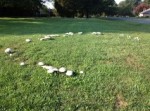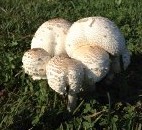 Have you every noticed that after a rainfall in spring or summer mushrooms spring up unexpectedly everywhere and are especially noticeable in lawns? The mushrooms may be small or large and may form circles that range in size from a few inches to 50 feet across, although most are between 2’ and 15’. The fact that the circles literally appear over night makes them seem “special” and in someway supernatural, hence the name, fairy ring.
Have you every noticed that after a rainfall in spring or summer mushrooms spring up unexpectedly everywhere and are especially noticeable in lawns? The mushrooms may be small or large and may form circles that range in size from a few inches to 50 feet across, although most are between 2’ and 15’. The fact that the circles literally appear over night makes them seem “special” and in someway supernatural, hence the name, fairy ring.
The mushrooms that form the fairy ring are the reproductive structures of the fungi that produce them. Underground beneath the mushrooms is a dense growth of thread-like structures called hyphae that form the body of a fungus, the mycelium. The mycelium grows in the soil using decomposing plant material such as grass clippings as food until conditions are just right and then it produces the mushrooms carrying spores in order to reproduce.

The fairy rings tend to recur in the same general area every year but in an ever-widening circle. Even when the mushrooms are not evident the fairy ring may be seen as a circle of lush grass where the fungus has increased the nitrogen supply as it decomposes organic matter such as grass clippings, or by a ring of dead grass where the fungus has impeded water penetration, used up the nutrients, or produced high levels of ammonia or other toxic waste products. The grass where a fairy ring occurs can be damaged by the fungi but good irrigation and fertilizing regimes usually help the lawn recover.
 Fairy rings have sparked the imagination of people all over Europe and have inspired artists and writers. Different cultures associate fairy rings with supernatural figures such as fairies, witches, elves, fire-tailed dragons, and the devil. Some people believe that fairy rings are dangerous places to be avoided while others think they are the entrance to the kingdom of elves, or places of good luck. Writers from Shakespeare to Yeats and Lord Byron wrote about fairy rings and many artists during the Victorian era found fairies dancing in a ring to be an appealing subject for their works.
Fairy rings have sparked the imagination of people all over Europe and have inspired artists and writers. Different cultures associate fairy rings with supernatural figures such as fairies, witches, elves, fire-tailed dragons, and the devil. Some people believe that fairy rings are dangerous places to be avoided while others think they are the entrance to the kingdom of elves, or places of good luck. Writers from Shakespeare to Yeats and Lord Byron wrote about fairy rings and many artists during the Victorian era found fairies dancing in a ring to be an appealing subject for their works.